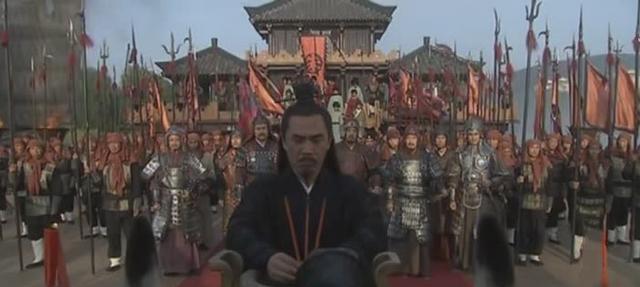After the founding of the Ming Dynasty, on the sixth day of the first month of the second year of Hongwu, Taizu ordered Yousi to build a temple of meritorious heroes on Jilong Mountain on the outskirts of Nanjing to commemorate the heroes who died in the battle of Daming. And explicitly ordered:
The deceased, whose image is enshrined in the temple, is still in the position of the living.
At the end of the second month of each season, the Minister of Xunqi was sent to sacrifice to Mount Jilong.

Zhu Yuanzhang film and television stills
During the Western Wu Dynasty, there were already temples of meritorious heroes everywhere. For example, the Yuzhang Zhongchen Temple and the FourteenThren, headed by Zhang Desheng. All are given to the Marquis of Marquis. There are thirty-five people in the Temple of Zhongchen on Kanglang Mountain, headed by Ding Pulang. He was also given the title of Marquis and other knights.
In Yuzhang and Kanglangshan, there were Zhang Desheng, Ding Pulang, Li Jixian, Left Deputy Marshal Zhao Guowang, Baihu Xuming, Xia Maocheng, Right Wing Marshal Tongzhi Zhu Qian, Marshal Xu Jue, Suffraged Liu Qi, Prefect Zhu Wenhua, Prefect Ye Chen and Provincial Governor Wan Sicheng, Privy Council Judge Zhang Zhixiong, Marshal Yu Chang, Right Marshal Chen Bi, Left Deputy Commander Han Cheng, Marshal Song Gui, Chen Zhaoxian, Deputy Marshal Chang Wengui, Left Marshal Li Xin, Wang Sheng, Liu Yi, Tongzhi Marshal Li Zhigao, Deputy Envoy Wang Zhizhuo, Qianhu Jiang Run, Wang Fengxian, Shi Ming, Shi Ming, Wang De, Zhu Ding, Wang Qing, Chang Desheng, Yuan Hua, Chen Chong, Wang Xixian, Wang Ze, Ding Yu, Shi Desheng, Pei Yi, Wang Li, Wang Ren, Zhenfu Chang Weide, Zheng Xing, Lu Deshan, Luo Shirong, Cao Xin, Privy Council Secretary Sang Shijie, General Zhi'an Yuan, Lieutenant Of Light Vehicles, Marquis of Yongyi, and Enjoy taimiao Temple.
Shen Wuwei commanded Yang Guoxing, Yongxing Wing Left Deputy Marshal Liu Cheng, presented General Huaiyuan, and established a temple changxing.
Mao Cheng, given to the Duke of Donghai County, is a temple of meritorious service. Forty-nine in all.
King Xu Da of Zhongshan went on a expedition
In February of the second year of Hongwu, the Jilong Mountain Temple was completed, sorted by merit and official position, headed by Xu Da, followed by Chang Yuchun and Li Wenzhong, with a total of 21 people. Later moved into Zhang Desheng and Spear Cheng.
In the spring of the eighth year, Taizu ordered an increase of 108 people. When Hu Dahai and others were martyred, Taizu remembered his merits and ordered his statue to be sculpted at the Bian Hu Jiang Ziwen Temple, and this time the statue was re-statued at the New Temple of Jilong Mountain. According to the "Great Ming HuiDian", the ranks of the six kings and fifteen dukes in the second year of Zi lie Hongwu are as follows:
King Kaiping often encounters a portrait of Chun
In the middle of the hall, the main arrangement is the six kings of the time
Xu Da, king of Zhongshan Wuning, often met Li Wenzhong, king of Wujing in Qiyang
Deng Yu, king of Wuxuan of Ninghe, Tang of Xiangwu, of Dong'ou, and Mu Ying, king of Zhaojing, Qianning
Portrait of Wang Muying of Qianning
East-west
Du commanded Feng Guo, the Duke of Ying, to use the Duke Geng Zaicheng of Xihai Wuzhuang
Ding Dexing, Duke of Jiguo, was the Governor of Jiguo and Zhang Desheng, the Duke of Zhicai
Marquis of Jinghai Xiangyi Duke Wu Zhen Pingzhang Xuanguo Wuyi Gong Kang Maocai
Deputy envoy to Donghae County
West-to-east
Hu Dahai, duke of Wuzhuang, who participated in the government of the State of Yue, was the governor of Tongzhi Liang, and Zhao, the Duke of Liang, was victorious
Guangde Marquis Chao Guo Wuzhuang Gonghua Gao Du Du Tong Zhi Guo Zhonglie Gong Yu Tonghai
Marquis Of Jiangyin, Marquis Of Jiangguo Xianglie, Duke Wu Liang, Marquis of Xuanning Marquis An Guo Zhonglie, Duke Cao Liangchen
Marquis Wu Zhen of the Marquis of Qianguo of Anlu was the deputy envoy of Marquis Sun Xingzu of Yanshan
The two temples of the Temple of Merit have a plaque on each side, and the general book:
Therefore, the hero commanded the spirit of the town support of thousands of households
Soon, Liao Yong'an, Yu Tonghai, Sang Shijie, Geng Zaicheng, Hu Dahai, and Zhao Desheng were entitled to the Taimiao Temple.
In March of the fourth leap year of Hongwu, Taizu gave meritorious servants to guard the tombs and households did not vary:
The four dukes of Korea, Li Shanchang, the Duke of Wei, Xu Da, the Duke of Zhengguo, and Feng Sheng, the Duke of Song, each gave 150 households to guard the tomb.
Portrait of Lee Sun-jang, Duke of Korea
Deng Yu the Duke of Weiguo, Tang Shengzong the Marquis of Yan'an, Lu Zhongheng the Marquis of Ji'an, Marquis Hua Yunlong of Huai'an, Marquis Gu Shi of Jining, Marquis Chen De of Linjiang, Marquis Geng Bingwen of Changxing, Marquis Wu Zhen of Jinghai, Governor Sun Ke, and Guo Zixing each gave 100 households to guard the tomb.